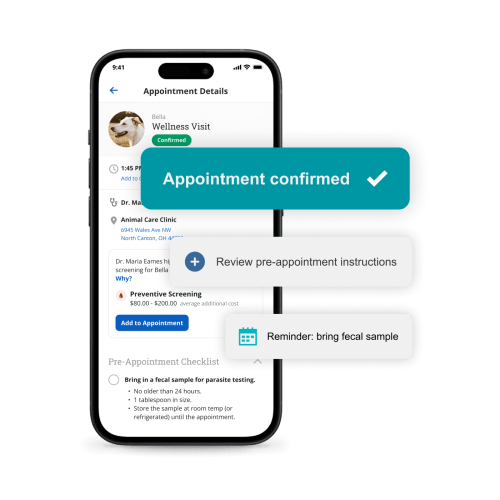Continuous Improvement in the Veterinary Practice

In a busy practice, initiating large-scale workflow changes or resolutions to practice-wide problems can be especially challenging or risky, as initiatives fail to take hold, worsen the existing issue, compromise team morale, or altogether miss the mark. However, fostering continuous improvement by implementing small, strategic, measurable changes can transform frustration and inefficiency into one of self-sustaining success.
The concept of continuous improvement
Continuous improvement is a business strategy that—as its name suggests—prioritizes consistent, incremental enhancements to the way certain skills or processes are performed. By breaking large objectives into smaller more measurable and attainable steps or changes, businesses employing continuous improvement can ultimately experience greater efficiency and progress toward larger goals while enjoying more team empowerment and less stress.
Continuous improvement in the veterinary practice
In a practice setting, continuous improvement strategies could be successfully applied to increase efficiency in various areas, improve patient care, and increase client and team satisfaction such as:
- Streamlining scheduling
- Simplifying check-in or checkout procedures
- Optimizing inventory management
- Assessing clinic layout and space utilization
- Incorporating new tools to increase team and client communication
- Updating patient care protocols
- Revising job descriptions and expectations for each team member
- Requesting and reviewing client feedback through surveys and reviews
Putting it to work: Implementing continuous improvement in the veterinary setting
At first glance, continuous improvement sounds like it requires continuous work. But remember, this strategy is about achieving gradual, small-scale results rather than total transformation—although with the right strategy, that is also possible! While some effort is necessary to implement continuous improvement, once the process is familiar and established within your team, the simple framework will feel like second nature. The continuous improvement process—Plan, Do, Check, Act (PDCA)—is a cyclical pattern based on the scientific method and includes:
Plan
Begin by identifying an area for improvement. Gather your team to discuss potential bottlenecks in your workflow, common client frustrations, or areas where delays or errors are frequent. These areas should be prioritized by their impact on the overall workflow. Break the biggest problem into smaller pieces, then determine an action plan to address each component.
Do
With your plan in place, appoint specific team members to key tasks to prevent overlap, confusion, and frustration. Ensure you know how and when you will be tracking progress and that the entire team understands the current objective and its role within the larger goal.
Check
At the appropriate time, test your plan by reviewing relevant quantitative or qualitative data, such as key performance indicators (KPI), team feedback, or client surveys, and checking them against the desired result or target. Be as objective as possible about the results, as the information here will guide your next step and impact your continuous improvement strategy’s overall success.
Act
If your plan has yielded appropriate results, such as a new client reminder app reducing no-show appointments, the Act step involves adopting the plan as a standardized or permanent part of the workflow. If the app fails to create any change or has led to increasing no-shows or client complaints, the idea may be discarded or reattempted with modification. Whether the plan is successful or not, the PDCA cycle can now begin again with another slightly larger goal—based on the newly standardized change and any insights or ideas from the first round—or a modified plan to reach the original goal such as providing clients with an opt-out option for automated text reminders.
The PDCA loop encourages regular review, assessment, and innovation for innumerable practice challenges. The intentionally incremental goals emphasized by the continuous improvement method keep veterinary teams feeling motivated, successful, and invested in ongoing effort and perpetual growth.
All aboard: The team’s critical role in continuous improvement
Every team member is important to continuous improvement, as each individual and role can provide a unique perspective, insights, and ideas on practice workflow and other challenges. In addition, soliciting team member input helps create a culture of learning, a sense of ownership over the plan’s success, and helps employees feel recognized for their daily work. Here are some simple ways to help your team embrace continuous improvement in practice:
- Foster a safe environment for change — Hold regular informal meetings to obtain team member feedback on practice workflows. Be open and transparent about known challenges and previously failed attempts to solve them. Admitting failure can help team members feel comfortable sharing ideas and feedback without fear of judgment.
- Empower the team with independent initiatives — Once the team understands continuous improvement and the PDCA cycle, encourage individuals or teams to take on specific areas and try out their solutions.
- Provide confidential feedback channels — This ensures that all concerns are addressed and all possible ideas and solutions receive equal consideration.
- Celebrate small wins and acknowledge effort — Continuous improvement is all about incremental progress, so celebrate small wins with your team to ensure long-term participation and continued success. Meanwhile, don’t discount failed efforts, which can be used as learning opportunities for future growth. In a change-averse team, acknowledging effort can be as powerful as celebrating a win!
As in clinical practice, improvement in veterinary workflow and efficiency can be gradual and incremental—sometimes painstakingly so. However, as long as each review and measurement shows progress, we trust the improvements we’ve made will be cumulative and lasting. By breaking big problems into achievable goals and then into actionable plans, continuous improvement strategies can help veterinary practices move forward toward greater efficiency, satisfaction, and long-term success.




